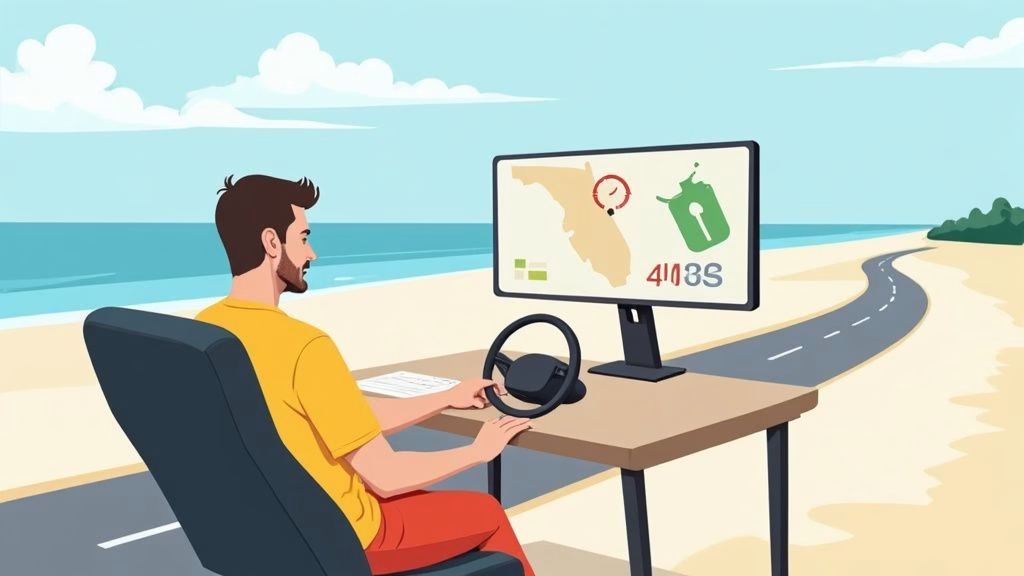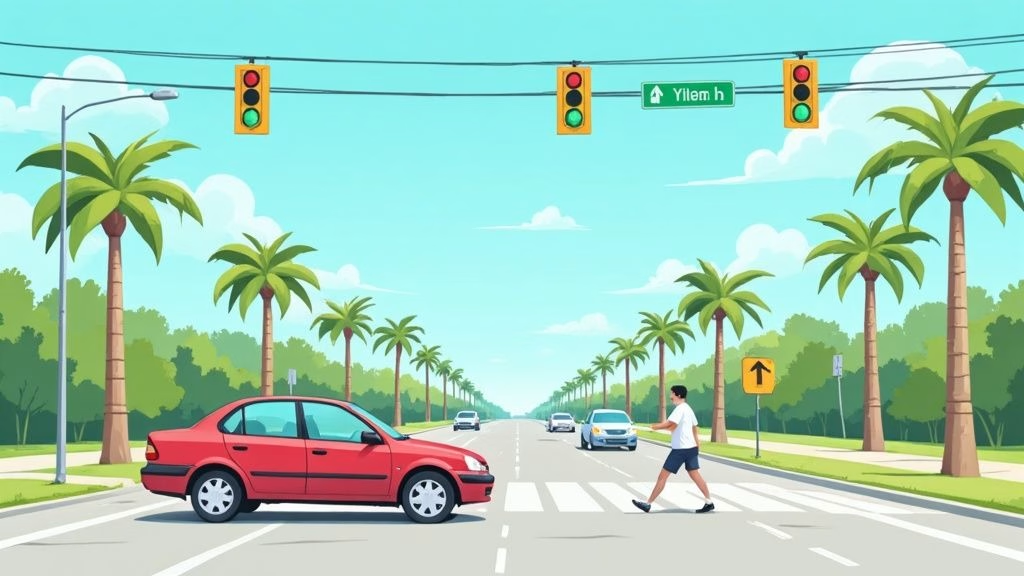Defensive driving classes teach advanced safety techniques that go beyond basic driver education. These courses focus on accident prevention through hazard recognition and proper vehicle control.
We at floridanewdriver.com know that understanding what is a defensive driving class can help you make informed decisions about your driving education. These programs offer practical benefits like insurance discounts and ticket dismissal options.
What Defensive Driving Classes Cover
Traffic Laws and Regulations
Defensive driving classes update drivers on current traffic laws that many overlook after license acquisition. The National Highway Traffic Safety Administration reports that 94% of serious traffic crashes involve human error, often from outdated knowledge of traffic regulations.
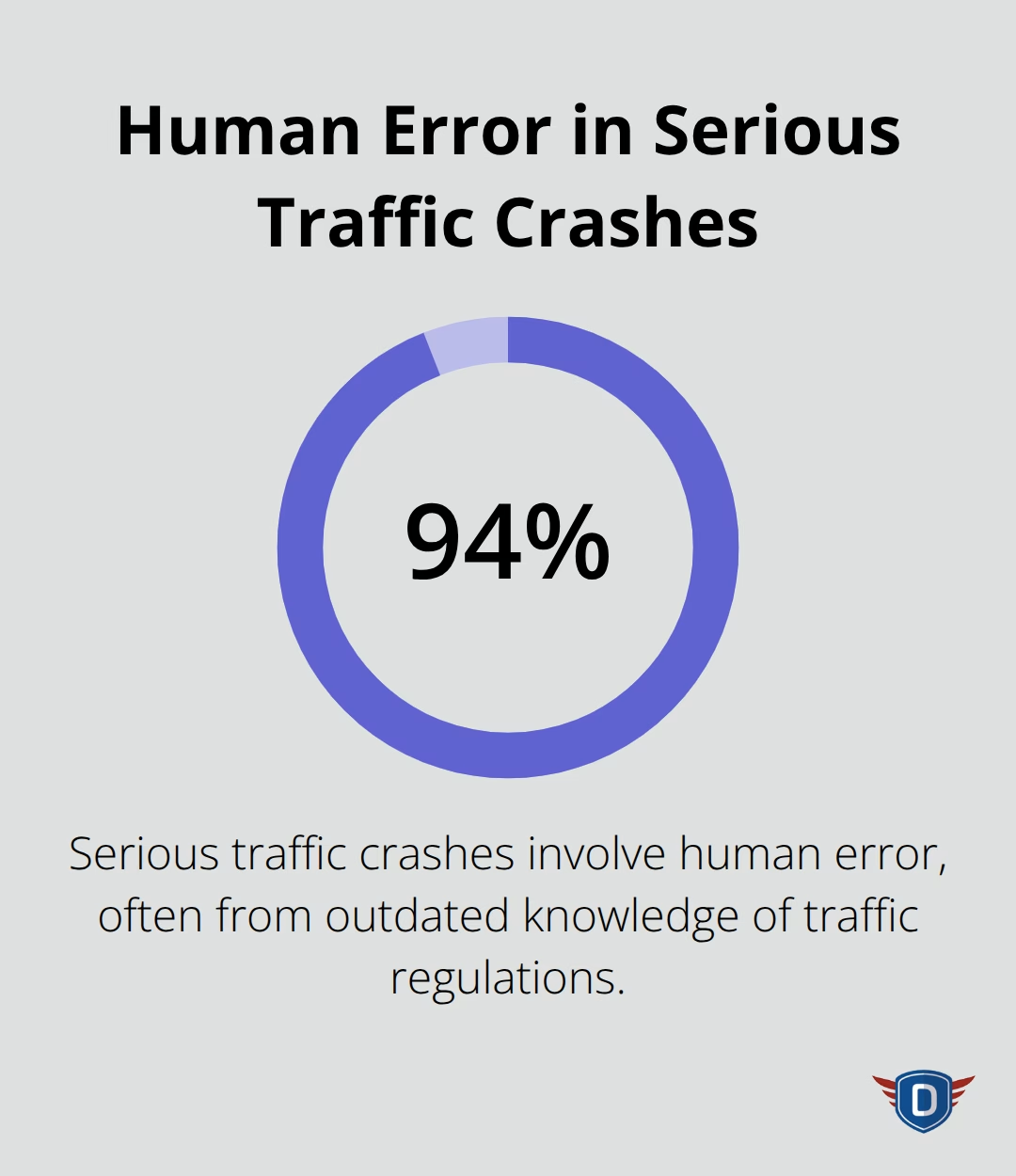
These courses refresh drivers on recent law changes, right-of-way rules, and specific violations that lead to accidents. Students study speed limit variations, intersection protocols, and parking regulations that vary by state. Instructors explain how specific violations like tailgating contribute to rear-end collisions.
Hazard Recognition and Risk Assessment
Professional instructors teach systematic hazard scanning methods that basic driver education rarely covers. The Smith System, used by commercial drivers, teaches the 5-point method for spotting potential dangers ahead.
Students practice identification of drunk drivers, distracted pedestrians, and weather-related road hazards through real scenarios. Courses emphasize proper following distance maintenance, which helps prevent rear-end crashes when properly applied. Advanced programs include night hazards, construction zone navigation, and emergency vehicle response protocols. These skills help reduce accident rates according to safety research.
Safe Following Distances and Speed Management
Instructors focus heavily on speed management beyond posted limits, teaching drivers to adjust for conditions like rain, fog, and heavy traffic. The courses explain how stopping distance increases with speed-at 35 mph, stopping distance reaches significant lengths on dry pavement.
Students learn proper following distance rules and when to increase distance during adverse conditions. Space cushion management includes lane positioning, merge timing, and escape route creation in traffic. These defensive driving techniques help drivers avoid contributing to traffic fatalities, with speed being a significant factor in fatal crashes in the United States.
Understanding these core components helps drivers appreciate the comprehensive nature of defensive education, but the real value becomes apparent when examining the tangible benefits these courses provide.
Benefits of Taking Defensive Driving Classes
Insurance Premium Reductions
Most major insurance companies offer discounts that range from 5% to 15% for drivers who complete approved defensive driving courses. State Farm, GEICO, and Progressive provide these reductions for drivers who finish certified programs, with savings that last three to five years (depending on the provider). Texas drivers can save up to 10% on their liability premiums through state-approved courses, while New York offers mandatory discounts for drivers over 55.
Teen drivers have crash rates nearly 4 times those of drivers 20 and older per mile driven, with immaturity leading to speeding and other risky habits. This data makes insurance discounts profitable for insurers and beneficial for policyholders who want to reduce their annual premiums.
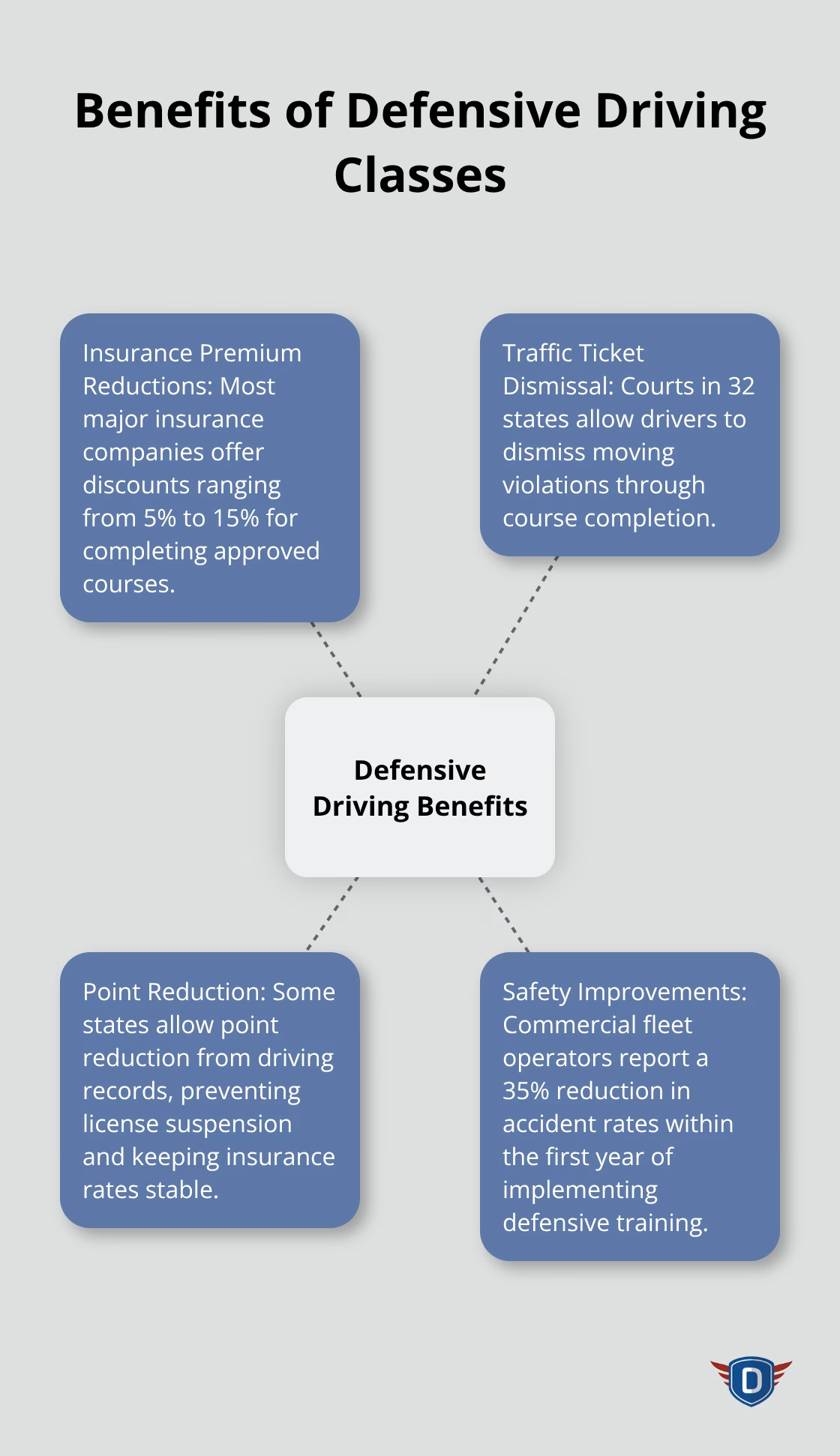
Traffic Ticket Dismissal and Point Reduction
Courts in 32 states allow drivers to dismiss moving violations through defensive driving course completion. Texas permits one ticket dismissal every 12 months, while Florida allows point reduction from records. California drivers can remove points for speeding violations under specific conditions (though restrictions apply based on violation type).
The American Safety Council reports that 85% of eligible drivers successfully dismiss their tickets through approved programs. Point removal prevents license suspension and keeps insurance rates stable when violations would otherwise cause increases.
Measurable Safety Improvements
Traffic crashes claimed 13% fewer lives in the first half of 2025 compared to the same period last year. Commercial fleet operators like UPS require defensive training because it reduces accident rates by 35% within the first year. Emergency response times improve significantly when drivers learn proper hazard recognition techniques.
Professional truck drivers who complete advanced defensive courses show 50% better reaction times during unexpected road situations, according to Federal Motor Carrier Safety Administration studies. These improvements translate directly to safer roads for all drivers.
The proven benefits of defensive driving education become even more valuable when you understand the different course formats available to match your schedule and learning preferences.
Types of Defensive Driving Courses Available
Online Defensive Driving Programs
Online defensive driving programs dominate the market because they offer maximum flexibility for busy schedules. These digital courses cost between $15 and $50 per state, with completion times that range from 4 to 8 hours (depending on state requirements).
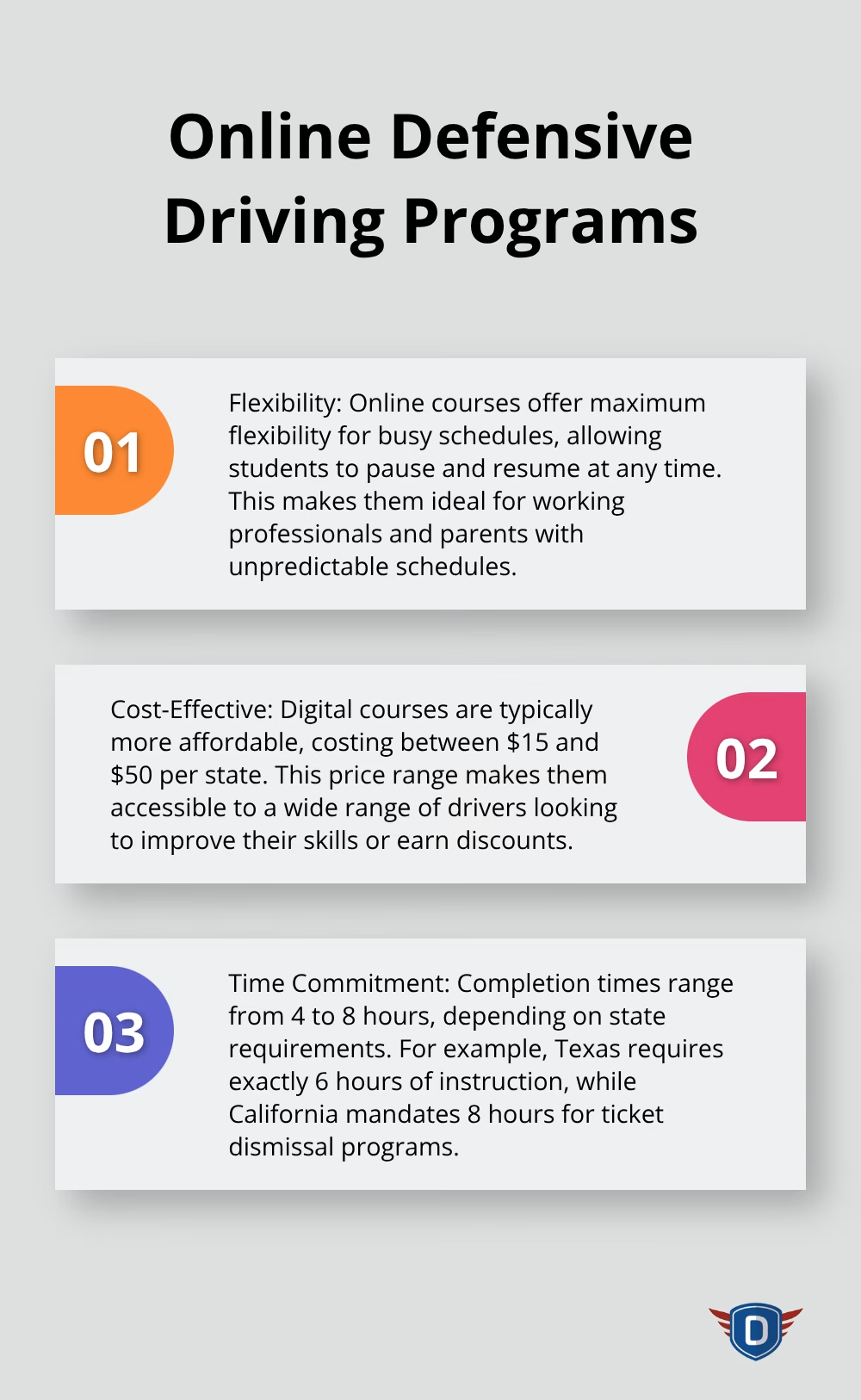
Texas requires exactly 6 hours of instruction, while California mandates 8 hours for ticket dismissal programs. Students can pause and resume courses at any time, which makes online programs ideal for working professionals and parents with unpredictable schedules.
In-Person Classroom Instruction
Traditional classroom instruction provides face-to-face interaction with certified instructors who answer questions immediately. These sessions typically run 6 to 8 hours in single-day formats or split across multiple evenings. Classroom programs cost $50 to $100 per student but include printed materials and group discussions that some learners prefer.
Instructors demonstrate techniques through physical props and whiteboard examples that help visual learners grasp concepts better. Students benefit from peer interaction and shared experiences that online courses cannot replicate (though scheduling flexibility remains limited compared to digital options).
Court-Ordered vs Voluntary Enrollment
Judges mandate defensive driving for specific violations like speeding tickets over 25 mph above the limit or reckless driving charges. Court-ordered students must complete courses within specified timeframes, with automatic license suspension penalties for non-compliance. These programs cost the same as voluntary enrollment but include additional reporting requirements to court systems.
Voluntary students enjoy more provider options and extended completion timeframes, typically up to one year from enrollment. Insurance companies accept both court-ordered and voluntary certificates equally for premium discounts, which makes voluntary completion a smart financial decision before violations occur.
Final Thoughts
Defensive driving education delivers measurable benefits that extend far beyond basic traffic law compliance. Insurance companies reduce premiums by 5% to 15% for drivers who complete these programs, while courts dismiss tickets for qualified participants. Commercial fleets report 35% fewer accidents after they implement defensive training programs, which proves the safety value of these courses.
Course format selection depends on individual preferences and schedule constraints. Online programs offer maximum flexibility at lower costs, while classroom instruction provides direct instructor interaction and peer discussion opportunities. Both formats deliver identical certification benefits for insurance discounts and court requirements (though completion timeframes may vary by state).
Understanding what is a defensive driving class helps drivers make informed decisions about their ongoing education. The long-term safety impact creates lasting value through improved hazard recognition skills and better decision-making under pressure. We at floridanewdriver.com offer comprehensive driver education programs that focus on safe driving habits and professional instruction for drivers who want to improve their skills.




